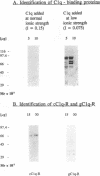Abstract
Human neutrophils have multiple C1q-binding proteins. Direct ligand-binding studies with the globular domain of C1q and two-dimensional Western blot analysis revealed two gC1q-binding proteins (gC1q-R): a 33,000 M(r) protein (pI 4.5) mainly in the neutrophil plasma membrane and an 80,000-90,000 M(r) protein (pI 4.1-4.2) located mainly in the granules. Direct binding studies showed that C1q bound to this higher molecular weight protein under physiological conditions. In contrast, anti-cC1q-R antibody, which recognizes a protein binding to collagenous tails of C1q, detected only a 68,000 M(r) protein in the plasma membrane. Both the 33,000 and 68,000 M(r) receptors appear early on the surface of differentiating HL-60 cells. On mature neutrophils, surface expression of both C1q receptors was evident, but no upregulation was observed upon stimulation. Phorbol myristate acetate treatment of neutrophils downregulated both the receptors from cell surface, and significant amounts of soluble gC1q-R were in cell media supernatants, suggesting receptor shedding or secretion. gC1q-R, unlike cC1q-R, did not bind to other C1q-like ligands, namely mannose binding protein, surfactant protein-A, surfactant protein-D, or conglutinin under normal ionic conditions, suggesting a greater specificity for C1q than the "collectin" type receptor (cC1q-R). Rather, gC1q-R only bound purified C1q, and the binding was enhanced under low ionic conditions and in the absence of calcium. The role of C1q receptor shedding and its biologic consequence remain to be defined, but may contribute to the diversity of C1q-mediated responses observed in many cell types.
Full text
PDF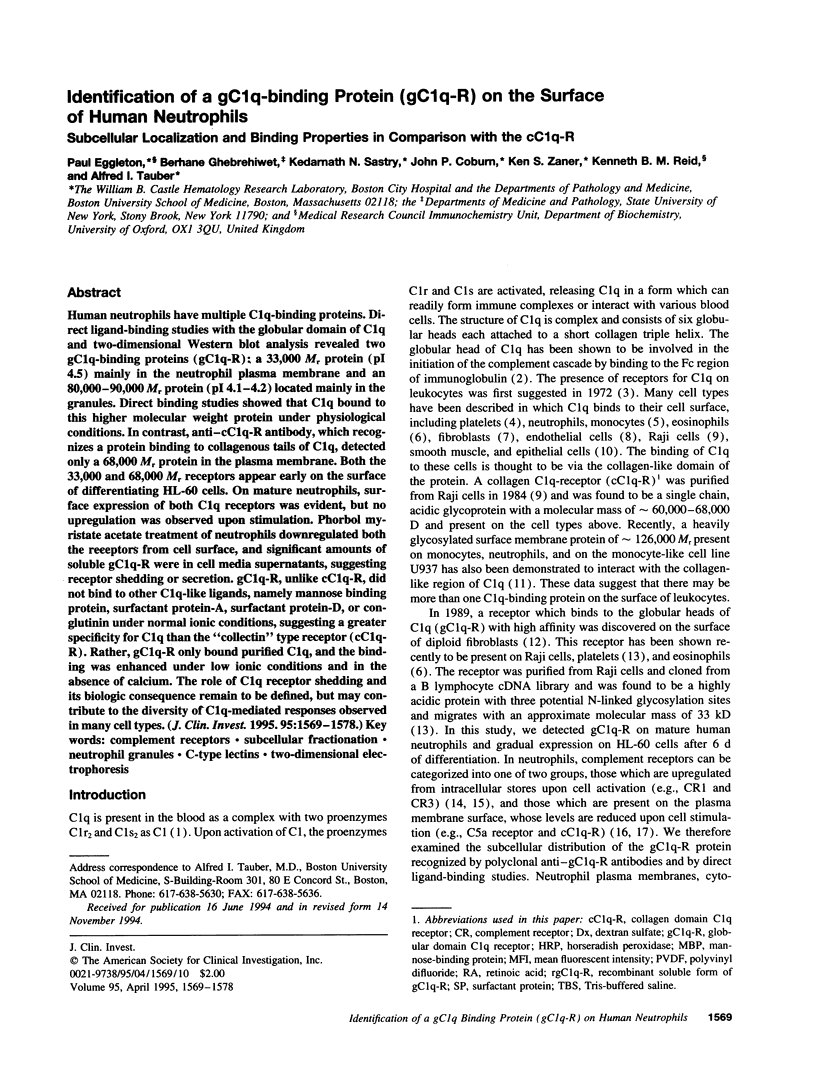
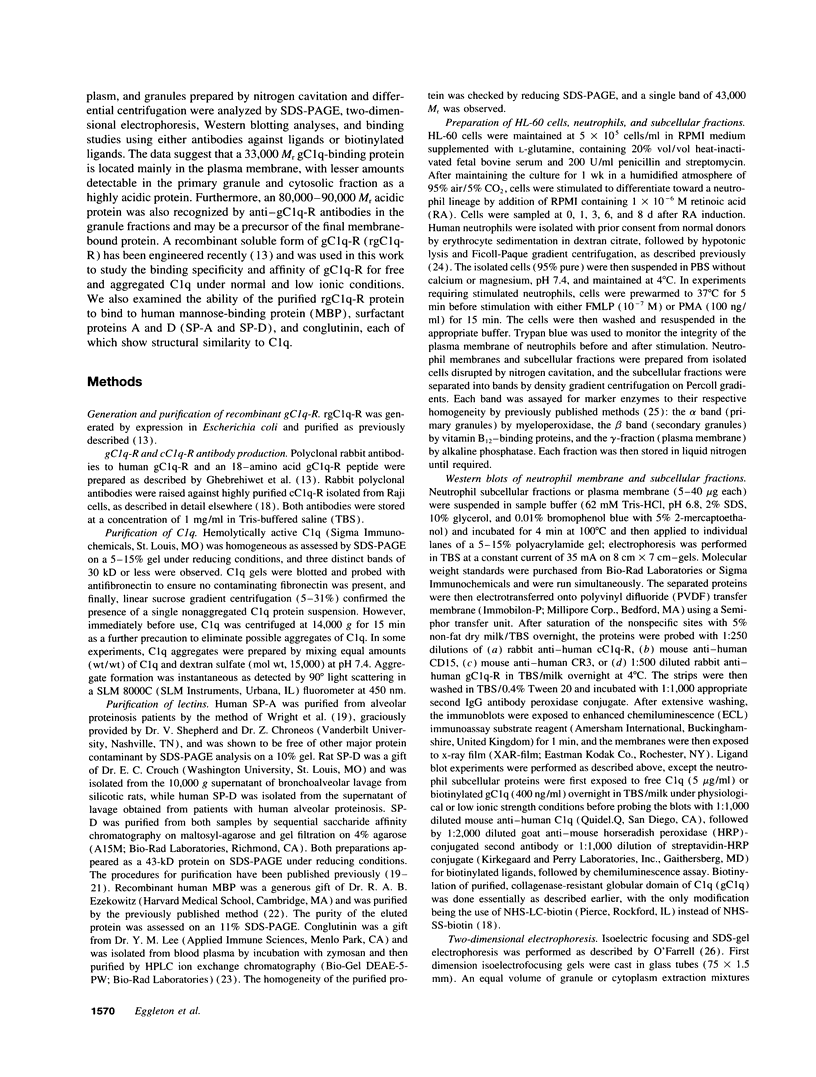
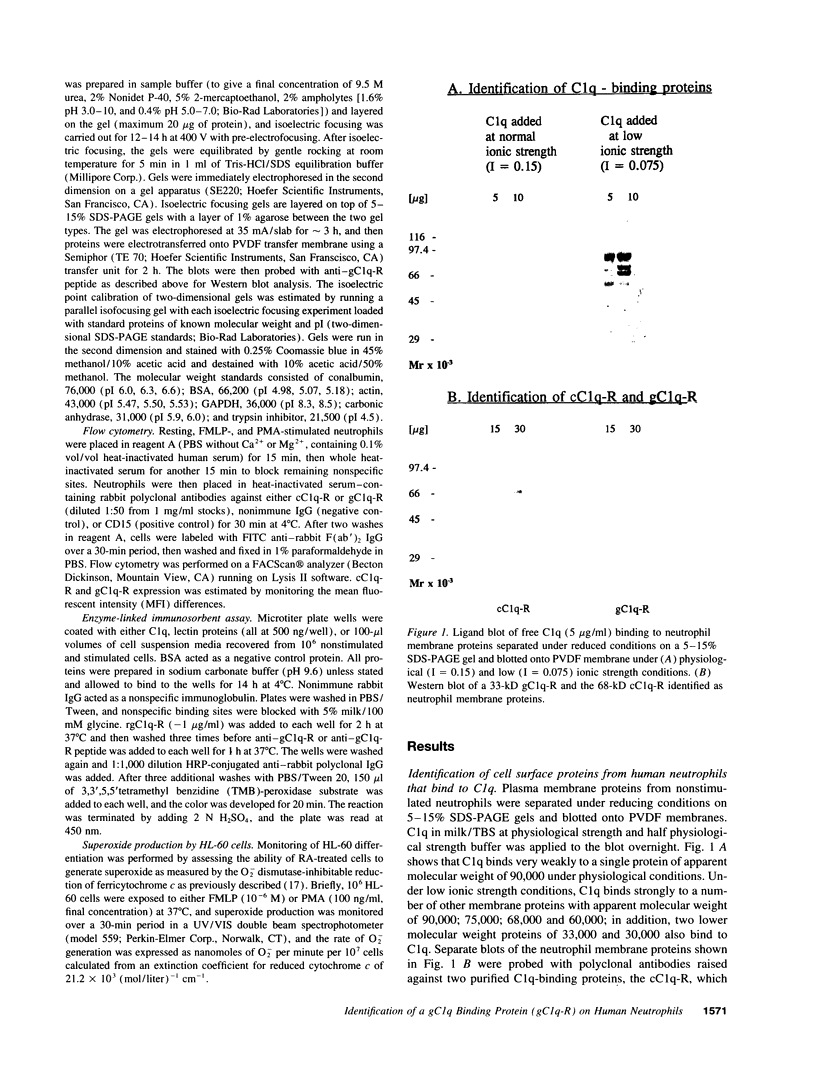

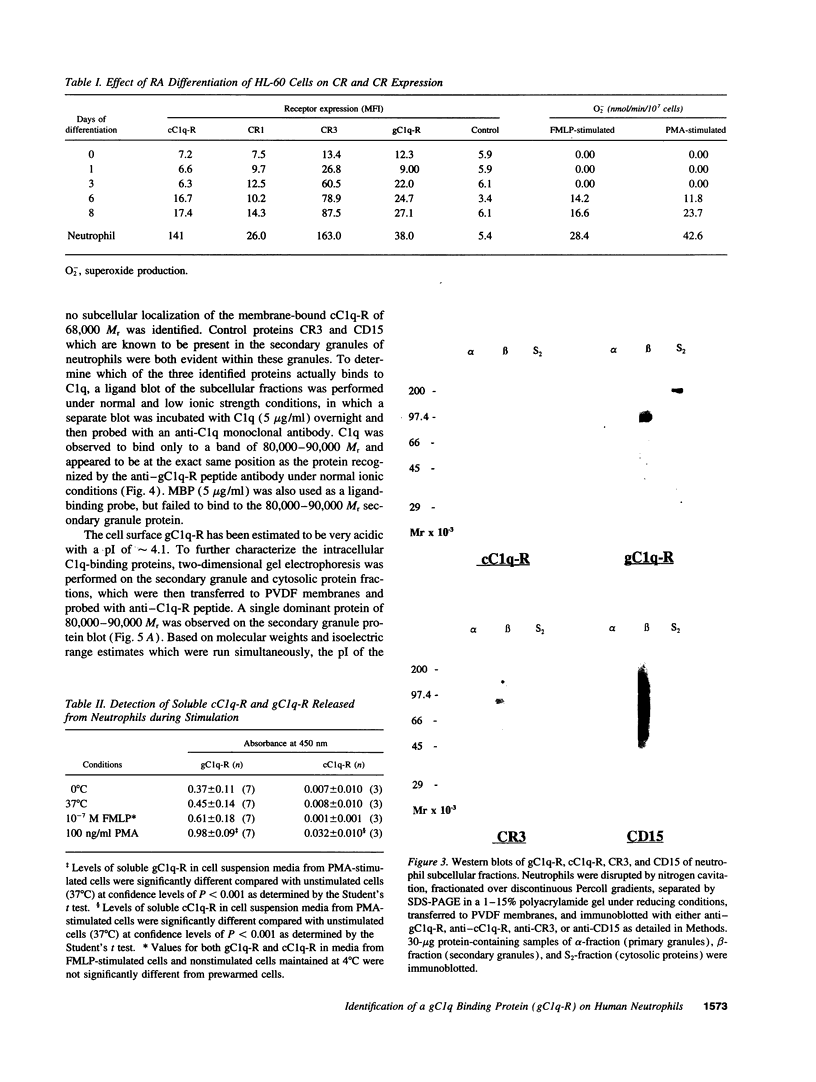
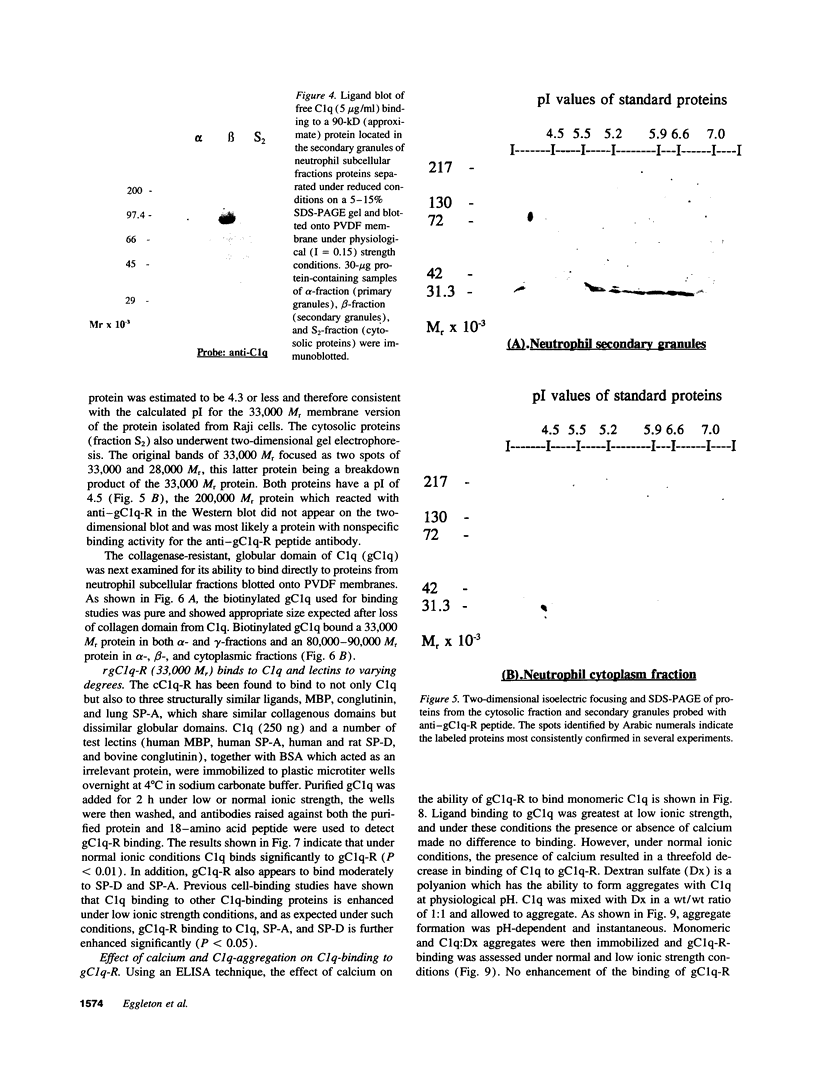
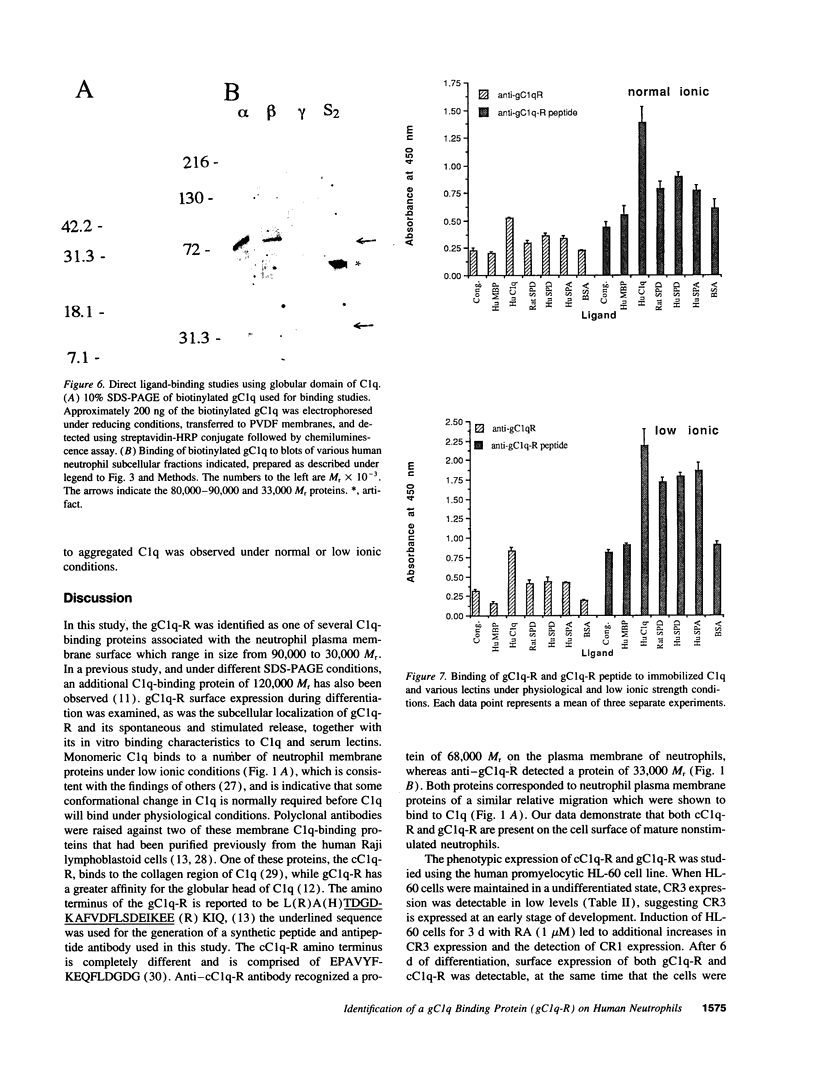
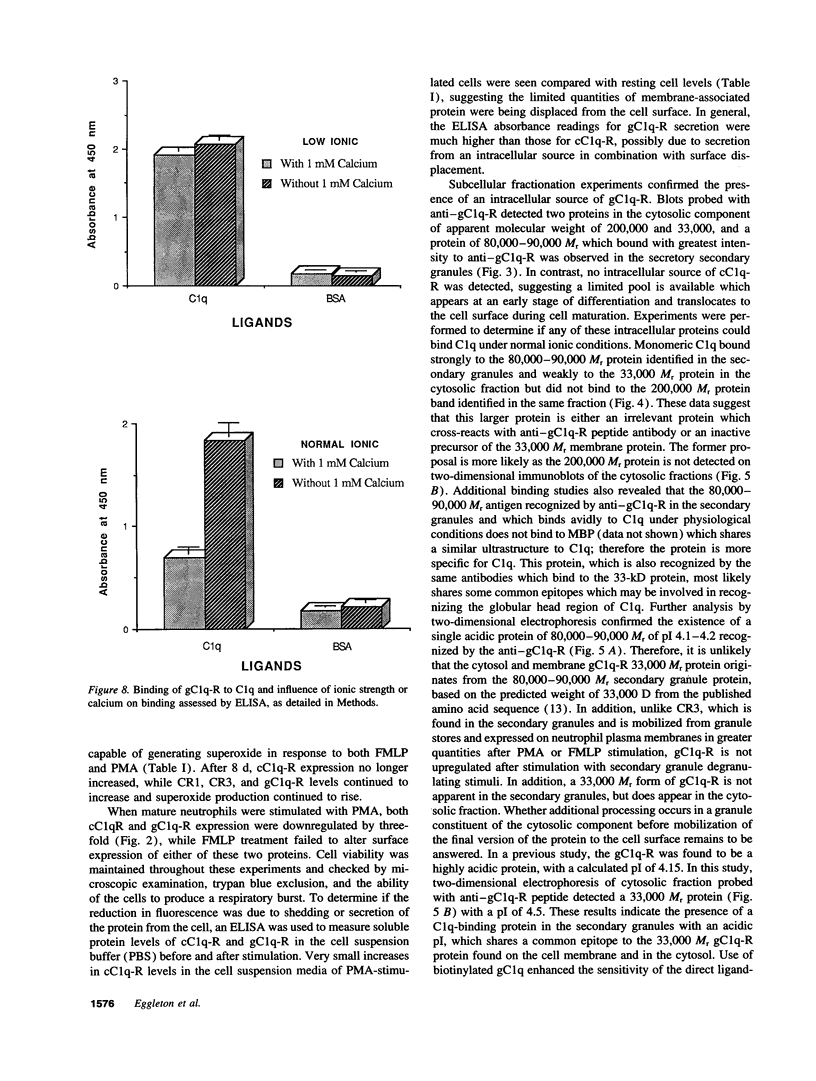
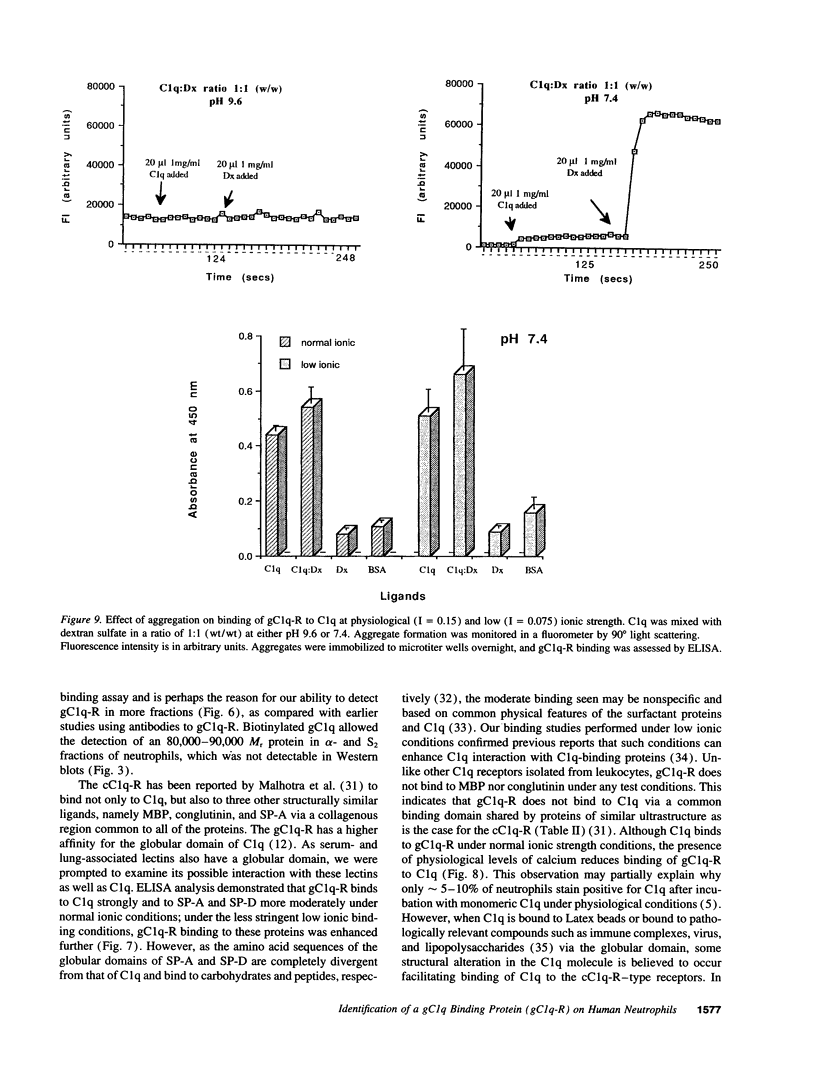
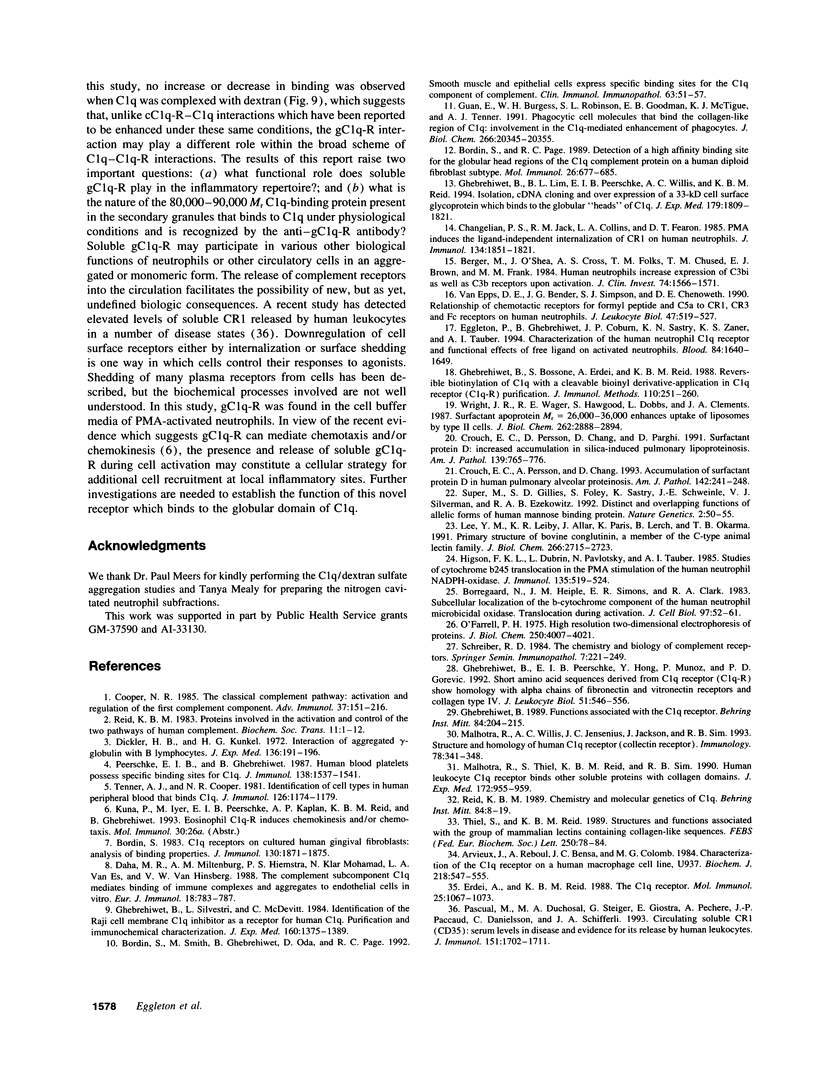
Images in this article
Selected References
These references are in PubMed. This may not be the complete list of references from this article.
- Arvieux J., Reboul A., Bensa J. C., Colomb M. G. Characterization of the C1q receptor on a human macrophage cell line, U937. Biochem J. 1984 Mar 1;218(2):547–555. doi: 10.1042/bj2180547. [DOI] [PMC free article] [PubMed] [Google Scholar]
- Berger M., O'Shea J., Cross A. S., Folks T. M., Chused T. M., Brown E. J., Frank M. M. Human neutrophils increase expression of C3bi as well as C3b receptors upon activation. J Clin Invest. 1984 Nov;74(5):1566–1571. doi: 10.1172/JCI111572. [DOI] [PMC free article] [PubMed] [Google Scholar]
- Bordin S., Kolb W. P., Page R. C. C1Q receptors on cultured human gingival fibroblasts: analysis of binding properties. J Immunol. 1983 Apr;130(4):1871–1875. [PubMed] [Google Scholar]
- Bordin S., Page R. C. Detection of a high-affinity binding site for the globular head regions of the C1q complement protein on a human diploid fibroblast subtype. Mol Immunol. 1989 Jul;26(7):677–685. doi: 10.1016/0161-5890(89)90051-5. [DOI] [PubMed] [Google Scholar]
- Bordin S., Smith M., Ghebrehiwet B., Oda D., Page R. C. Smooth muscle and epithelial cells express specific binding sites for the C1q component of complement. Clin Immunol Immunopathol. 1992 Apr;63(1):51–57. doi: 10.1016/0090-1229(92)90093-4. [DOI] [PubMed] [Google Scholar]
- Borregaard N., Heiple J. M., Simons E. R., Clark R. A. Subcellular localization of the b-cytochrome component of the human neutrophil microbicidal oxidase: translocation during activation. J Cell Biol. 1983 Jul;97(1):52–61. doi: 10.1083/jcb.97.1.52. [DOI] [PMC free article] [PubMed] [Google Scholar]
- Changelian P. S., Jack R. M., Collins L. A., Fearon D. T. PMA induces the ligand-independent internalization of CR1 on human neutrophils. J Immunol. 1985 Mar;134(3):1851–1858. [PubMed] [Google Scholar]
- Cooper N. R. The classical complement pathway: activation and regulation of the first complement component. Adv Immunol. 1985;37:151–216. doi: 10.1016/s0065-2776(08)60340-5. [DOI] [PubMed] [Google Scholar]
- Crouch E., Persson A., Chang D. Accumulation of surfactant protein D in human pulmonary alveolar proteinosis. Am J Pathol. 1993 Jan;142(1):241–248. [PMC free article] [PubMed] [Google Scholar]
- Crouch E., Persson A., Chang D., Parghi D. Surfactant protein D. Increased accumulation in silica-induced pulmonary lipoproteinosis. Am J Pathol. 1991 Oct;139(4):765–776. [PMC free article] [PubMed] [Google Scholar]
- Daha M. R., Miltenburg A. M., Hiemstra P. S., Klar-Mohamad N., Van Es L. A., Van Hinsbergh V. W. The complement subcomponent C1q mediates binding of immune complexes and aggregates to endothelial cells in vitro. Eur J Immunol. 1988 May;18(5):783–787. doi: 10.1002/eji.1830180519. [DOI] [PubMed] [Google Scholar]
- Dickler H. B., Kunkel H. G. Interaction of aggregated -globulin with B lymphocytes. J Exp Med. 1972 Jul 1;136(1):191–196. doi: 10.1084/jem.136.1.191. [DOI] [PMC free article] [PubMed] [Google Scholar]
- Eggleton P., Ghebrehiwet B., Coburn J. P., Sastry K. N., Zaner K. S., Tauber A. I. Characterization of the human neutrophil C1q receptor and functional effects of free ligand on activated neutrophils. Blood. 1994 Sep 1;84(5):1640–1649. [PubMed] [Google Scholar]
- Erdei A., Reid K. B. The C1q receptor. Mol Immunol. 1988 Nov;25(11):1067–1073. doi: 10.1016/0161-5890(88)90139-3. [DOI] [PubMed] [Google Scholar]
- Ghebrehiwet B., Bossone S., Erdei A., Reid K. B. Reversible biotinylation of C1q with a cleavable biotinyl derivative. Application in C1q receptor (C1qR) purification. J Immunol Methods. 1988 Jun 13;110(2):251–260. doi: 10.1016/0022-1759(88)90111-1. [DOI] [PubMed] [Google Scholar]
- Ghebrehiwet B. Functions associated with the C1q receptor. Behring Inst Mitt. 1989 Jul;(84):204–215. [PubMed] [Google Scholar]
- Ghebrehiwet B., Lim B. L., Peerschke E. I., Willis A. C., Reid K. B. Isolation, cDNA cloning, and overexpression of a 33-kD cell surface glycoprotein that binds to the globular "heads" of C1q. J Exp Med. 1994 Jun 1;179(6):1809–1821. doi: 10.1084/jem.179.6.1809. [DOI] [PMC free article] [PubMed] [Google Scholar]
- Ghebrehiwet B., Peerschke E. I., Hong Y., Munoz P., Gorevic P. D. Short amino acid sequences derived from C1q receptor (C1q-R) show homology with the alpha chains of fibronectin and vitronectin receptors and collagen type IV. J Leukoc Biol. 1992 Jun;51(6):546–556. doi: 10.1002/jlb.51.6.546. [DOI] [PubMed] [Google Scholar]
- Ghebrehiwet B., Silvestri L., McDevitt C. Identification of the Raji cell membrane-derived C1q inhibitor as a receptor for human C1q. Purification and immunochemical characterization. J Exp Med. 1984 Nov 1;160(5):1375–1389. doi: 10.1084/jem.160.5.1375. [DOI] [PMC free article] [PubMed] [Google Scholar]
- Guan E. N., Burgess W. H., Robinson S. L., Goodman E. B., McTigue K. J., Tenner A. J. Phagocytic cell molecules that bind the collagen-like region of C1q. Involvement in the C1q-mediated enhancement of phagocytosis. J Biol Chem. 1991 Oct 25;266(30):20345–20355. [PubMed] [Google Scholar]
- Higson F. K., Durbin L., Pavlotsky N., Tauber A. I. Studies of cytochrome b-245 translocation in the PMA stimulation of the human neutrophil NADPH-oxidase. J Immunol. 1985 Jul;135(1):519–524. [PubMed] [Google Scholar]
- Lee Y. M., Leiby K. R., Allar J., Paris K., Lerch B., Okarma T. B. Primary structure of bovine conglutinin, a member of the C-type animal lectin family. J Biol Chem. 1991 Feb 15;266(5):2715–2723. [PubMed] [Google Scholar]
- Malhotra R., Thiel S., Reid K. B., Sim R. B. Human leukocyte C1q receptor binds other soluble proteins with collagen domains. J Exp Med. 1990 Sep 1;172(3):955–959. doi: 10.1084/jem.172.3.955. [DOI] [PMC free article] [PubMed] [Google Scholar]
- Malhotra R., Willis A. C., Jensenius J. C., Jackson J., Sim R. B. Structure and homology of human C1q receptor (collectin receptor). Immunology. 1993 Mar;78(3):341–348. [PMC free article] [PubMed] [Google Scholar]
- O'Farrell P. H. High resolution two-dimensional electrophoresis of proteins. J Biol Chem. 1975 May 25;250(10):4007–4021. [PMC free article] [PubMed] [Google Scholar]
- Pascual M., Duchosal M. A., Steiger G., Giostra E., Pechère A., Paccaud J. P., Danielsson C., Schifferli J. A. Circulating soluble CR1 (CD35). Serum levels in diseases and evidence for its release by human leukocytes. J Immunol. 1993 Aug 1;151(3):1702–1711. [PubMed] [Google Scholar]
- Peerschke E. I., Ghebrehiwet B. Human blood platelets possess specific binding sites for C1q. J Immunol. 1987 Mar 1;138(5):1537–1541. [PubMed] [Google Scholar]
- Reid K. B. Chemistry and molecular genetics of C1q. Behring Inst Mitt. 1989 Jul;(84):8–19. [PubMed] [Google Scholar]
- Reid K. B. Proteins involved in the activation and control of the two pathways of human complement. Biochem Soc Trans. 1983 Jan;11(1):1–12. doi: 10.1042/bst0110001. [DOI] [PubMed] [Google Scholar]
- Schreiber R. D. The chemistry and biology of complement receptors. Springer Semin Immunopathol. 1984;7(2-3):221–249. doi: 10.1007/BF01893021. [DOI] [PubMed] [Google Scholar]
- Super M., Gillies S. D., Foley S., Sastry K., Schweinle J. E., Silverman V. J., Ezekowitz R. A. Distinct and overlapping functions of allelic forms of human mannose binding protein. Nat Genet. 1992 Sep;2(1):50–55. doi: 10.1038/ng0992-50. [DOI] [PubMed] [Google Scholar]
- Tenner A. J., Cooper N. R. Identification of types of cells in human peripheral blood that bind C1q. J Immunol. 1981 Mar;126(3):1174–1179. [PubMed] [Google Scholar]
- Thiel S., Reid K. B. Structures and functions associated with the group of mammalian lectins containing collagen-like sequences. FEBS Lett. 1989 Jun 19;250(1):78–84. doi: 10.1016/0014-5793(89)80689-1. [DOI] [PubMed] [Google Scholar]
- Van Epps D. E., Bender J. G., Simpson S. J., Chenoweth D. E. Relationship of chemotactic receptors for formyl peptide and C5a to CR1, CR3, and Fc receptors on human neutrophils. J Leukoc Biol. 1990 Jun;47(6):519–527. doi: 10.1002/jlb.47.6.519. [DOI] [PubMed] [Google Scholar]
- Wright J. R., Wager R. E., Hawgood S., Dobbs L., Clements J. A. Surfactant apoprotein Mr = 26,000-36,000 enhances uptake of liposomes by type II cells. J Biol Chem. 1987 Feb 25;262(6):2888–2894. [PubMed] [Google Scholar]



